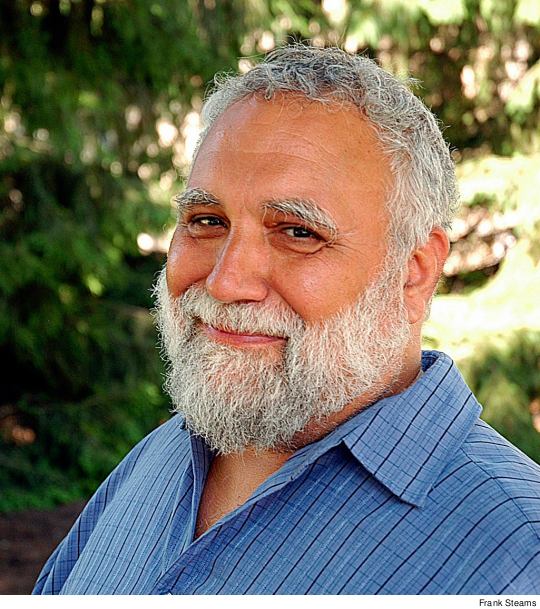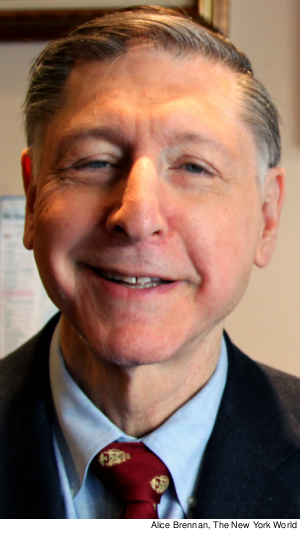Several years ago, Harry Levine took to shoving bar graphs into people’s faces. A friendly hello at a Christmas party or on the street: it was all the excuse he needed to rummage through his briefcase for his chart on marijuana arrests in New York City.
 |
It wasn’t his usual style. Levine was a professor of sociology at Queens College, nearly a quarter of a century into his career, and more accustomed to making his points through a journal article. He was co-editor of a well-regarded book on crack cocaine, which Columbia sociologist Herbert Gans said should be “required reading for the White House.” But while the drug war was not a new subject for Levine, this data discovery felt different.
LOW-LEVEL
Arrests for low-level marijuana possession had exploded in New York City. From 1987 through 1996, there had been roughly 30,000 such arrests. The following decade, the figure climbed to 353,000 – more than a tenfold increase. Equally striking, he found, were the racial disparities: in the last ten years, 54% of those arrested for marijuana possession have been black, 33% Latino, and 11% have been white.
Put another way, the marijuana arrest rate is seven times higher for blacks, and four times higher for Latinos, than for whites. Yet federal surveys of adults 18 to 25 have consistently found that white respondents used marijuana at higher rates than other racial groups, and most of these New York City arrests were people under age 26.
“I was a lunatic preacher,” Levine said, chuckling at the memory of himself as a pest. But times have changed and Levine is no longer a pest, but an inspiration.
This June, 2012, thousands of New Yorkers marched in silence toward Mayor Michael Bloomberg’s Fifth Avenue residence to call for an end to the New York Police Department’s controversial stop-and-frisk policy. These street-corner dragnets unfairly target blacks and Latinos, protesters charged – a claim bolstered by Levine’s research.
MEDIA SPOTLIGHT
As the debate over stop-and-frisk began heating up, Levine’s findings gained increased attention, His work was featured in The New York Times, the Associated Press, the Wall Street Journal, New York and others. “Much of what we know about the racial discrepancy between marijuana use and marijuana arrests in New York comes largely from the research of one man: Queens College sociology professor Harry Levine,” the Village Voice reported last year.
Today, says Donna Lieberman, executive director of the New York Civil Liberties Union, “it’s generally accepted that of the 50,000 annual marijuana arrests, a significant chunk arise from the unlawful stop-and-frisk policy.” Levine’s findings called into question “the claim that the NYPD’s hyper-aggressive policing is about going where the crime is.”
Levine’s scholarship may stand out, but he’s not alone: other CUNY faculty have also played important roles in the stop-and-frisk debate. The polarized atmosphere in the city has been such that aiming a critical eye at the NYPD – even as a scholar – can feel like stepping into the gladiator’s ring. It’s forced faculty to think deeply about the relationship between scholarship, policy analysis, advocacy and activism, and how they define the responsibilities of an intellectual.
“It’s not our job to change policy, but it is our job to inform policy makers,” said Eli Silverman, professor emeritus at John Jay College of Criminal Justice. His decade-long research into the NYPD’s alleged manipulation of crime statistics sheds light on the abuse of tactics like stop-and-frisk. It has also provided academic support for the criticisms raised by a number of whistle-blowers who have stepped forward in recent years at great personal and professional risk.
 |
With John Eterno, a professor of criminal justice at Molloy College, Silverman is co-author of The Crime Numbers Game: Management by Manipulation. In this book and other work, Silverman and Eterno argue that the NYPD has underreported more serious crimes while increasing street stops and summonses. On the one hand, this artificially lowers the city’s reported crime rate; on the other, high numbers of street stops are a way to claim credit for the apparent reduction.
“The NYPD seeks to keep the serious crime numbers low while showing lots of officer activity,” the co-authors wrote in an op-ed this August. “The NYPD’s 50,000 marijuana arrests, 600,000 summonses and nearly 700,000 stop-and-frisks do little or nothing to make the city safer.” Police find a gun in only one-tenth of 1% of all stop-and-frisks, and 94% produce no arrest of any kind. In fact, said Levine and Eterno, “this unnecessary activity alienates communities and hurts the NYPD’s ability to fight serious and violent crimes.”
Such claims, in the face of New York City’s much touted 40-year drop in crime, have provoked an ire that Silverman didn’t fully expect. “Anti-cop idiocy,” read the headline of a New York Post editorial blasting his and Eterno’s research. The Post did not see fit to mention that Eterno was himself a cop for 21 years, retiring from the NYPD as a captain in 2004.
TRUTH TO POWER
“When we first surveyed retired captains and higher, we had no idea the kind of results we’d get,” Silverman told Clarion. “We were flabbergasted by the extent of the acknowledged manipulation.”
As data flowed in, Silverman recalls having an early conversation with Eterno about the impact on the city and the police department of publishing findings that conflicted with the NYPD’s public image. Particularly after 9/11 and under Commissioner Ray Kelly’s leadership, the force was seen by many as almost above criticism.
“Do we not convey our results?” Silverman said to Clarion. He frames it as a question, but it’s rhetorical: while he and Eterno knew they might provoke a reaction, their choice was clear from the start. “If you don’t speak truth to power,” Silverman said, “if you don’t supply people with the information that you’ve secured and the studies you’ve done, you might as well hang up your shingle.”
Alex Vitale, associate professor of sociology at Brooklyn College, says criminal justice policy has largely been driven by broader ideological battles rather than by careful research or evidence-based analysis. Criminologists increasingly realize, he said, that if they want public policy to take scholarship into account, they can’t shy away from the public debate. “If we want to be relevant,” Vitale said, “we have to more directly engage in the politics of issues like stop-and-frisk.”
Last spring, Vitale started working with the Urban Justice Center’s Police Reform Organizing Project. As the group’s policy advisor, he aims to do more to connect advocates with the fruits of criminal justice research. For example, gun buybacks are popular among some of the strongest critics of stop-and-frisk, but Vitale says that studies have proven them ineffective.
In addition to scholarship and advocacy, Jim Vrettos, of John Jay College, says that social scientists sometimes need to engage in direct action and public protest. Vrettos, an adjunct assistant professor of sociology, was arrested last October, 2011 with activist academic Cornel West and 17 others at a police station in Harlem during the city’s first act of civil disobedience against stop-and-frisk.
“There’s no easy answer,” Vrettos said, when reviewing his decision to participate in the protest. “But I do think public academics have to make a decision. Try to be as objective as you can – but sometimes you have to get out of the offices and libraries and take a stand.”
Vrettos credits his students at John Jay with educating him over the years about the personal impact of stop-and-frisk – the disrespect and humiliation that they repeatedly experience.
In turn, Vrettos’ arrest had a positive effect on the introductory sociology class he was teaching at the time, sparking a particularly lively and engaging discussion. Whether they agreed or disagreed with his decision, he said, students were eager to discuss both his arrest and how the broader issue should be understood.
“The goal of teaching is to encourage critical thinking,” Vrettos told Clarion – and his arrest turned out to be a useful tool toward that end.
“Getting arrested is pretty scary,” Vrettos said, but “if I had to, I would certainly do it again.”
In fact, Vrettos is planning to participate with West and others in, “Blow the Whistle on Stop-and-Frisk,” the first of what’s expected to be a fresh wave of citywide protest this fall. Vrettos’ civil disobedience last October, 2011 helped to keep stop-and-frisk in the headlines at a time when it was starting to draw wider public attention.
The experience of Vrettos’s students is all too common in CUNY’s student body. “Many of my students have been stopped and frisked,” said Lenny Dick, an adjunct at Bronx Community College. “One very quiet young lady told me police said her backpack ‘looked too big.’” At a recent forum held by BCC’s Political Science Club, Dick said, many student recounted similar stories: “CUNY provides a place for students to talk about these issues, and, if they so choose, to organize to change them.”
The past year has seen growing criticism of the tactic, and elected officials are starting to consider policy change. This past June 2012, Governor Mario Cuomo called on the state legislature to downgrade the public possession of 25 grams or less of marijuana from a misdemeanor to a violation. The governor argued that with this change, stop-and-frisks should no longer result in so many – or such racially disproportionate – marijuana arrests.
DISCONCERTING
“I went to bed one night and woke up the next day to the governor, mayor, police commissioner and five district attorneys all agreeing with me,” Levine said with his characteristic chuckle. “Talk about disconcerting!”
But while Levine is glad to no longer be a voice in the wilderness, he says that a real solution may not be so close at hand. While a violation is non-criminal, if a defendant misses their day in court, which is common, it results in a criminal charge. How often does this happen? Nobody knows, said Levine, because there is no public data on that question.
Levine warned journalist Natasha Lennard that “without legislative or policy reform to make marijuana possession summonses traceable,…[s]top-and-frisk practices [could] remain as discriminatory as ever, with even less data available to prove it.” An engaged scholar’s work, it seems, is never done.

